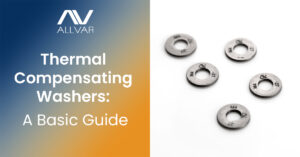In the realm of controlled thermal expansion, there is a new challenger to Invar’s long held title. ALLVAR Alloys offer a new approach to solve thermal expansion issues. The similarity in name is no coincidence. Invar is an iron-nickel alloy that exhibits a very low, isotropic CTE (Coefficient of Thermal Expansion) while ALLVAR Alloy 30 is a titanium alloy that exhibits a highly negative, anisotropic CTE. As a result, ALLVAR Alloy 30 is non-magnetic, lower density, and corrosion resistant compared to Invar. As we like to say, “ALLVAR Alloy 30 is all the VAR that Invar isn’t.”
A Brief History of Low Thermal Expansion Alloys
When discovered in 1895 by Swiss physicist Charles Guillaume, Invar’s low coefficient of thermal expansion enabled a technological leap in precision instruments that won Guillaume a Nobel Prize . Since its first discovery, various forms and compositions of Kovar, Invar, and Super Invar have been developed and extensively studied. Near Room temperature CTE’s for these alloys range from ~0.720 ppm/°C for Super Invar (25°C to 96°C), ~1.6 ppm/°C for Invar (25°C to 96°C), and ~5.2 ppm/°C for Kovar (25°C to 200°C). Invar’s thermal expansion coefficient is isotropic, which means it is the same value in every direction. This means a complex component can be machined from a single block of Invar and it will exhibit the same CTE in all directions.
Since their original discovery in 2011, ALLVAR Alloys have been developed to offer a wide range of thermal expansion values for various products and applications. ALLVAR Alloy 30 was designed to have as negative a CTE as possible with a value of -30 ppm/°C. Using this novel property, designers and engineers can compensate for the natural thermal expansion of other materials in an assembly. For the first time, a designer can choose a CTE anywhere between -30 ppm/°C and the CTE of the most positive material in their system by simply changing the length of the ALLVAR Alloy component. The tradeoff is that ALLVAR Alloys exhibit anisotropic CTE, which means the thermal expansion is different in various directions. A typical bar of ALLVAR Alloy 30 will exhibit -30 ppm/°C along its length and +31 ppm/°C in the diameter.
Machinability and Heat Treatments
To ensure CTE and dimensional stability in service, Invar requires special machining processes that include stress-relieving heat treatments for a consistent CTE in a precision machined part. These heat treatments add significant cost and time to making Invar components. Additionally, Invar is difficult to machine due to rapid wear of cutting tools. While Invar has a relatively low raw material cost, these requirements significantly increase the cost of a precision component. There are several excellent resources available if you need help machining Invar alloys.
ALLVAR Alloys are easier to machine than Invar components, but there are some things you need to know before machining it. ALLVAR Alloys machine like a beta-titanium. With the right feeds and speeds and a knowledgeable machinist experienced with titanium alloys, it machines well. Additionally, ALLVAR Alloy 30 has a maximum operating temperature of 100°C. Special care should be given to flood the cutting surface with coolant and “peck” when drilling holes. ALLVAR Alloys are also similar to commonly used wrought alloys like aluminum or normal titanium in that a stabilizing process is required for high precision applications. The ALLVAR team has developed proprietary stabilizing processes for normal (0°C to 50°C), medium (-40°C to 80°C), and extreme (cryogenic to 100°C) operating temperature ranges. If machining titanium is not in your company’s wheelhouse and stability is key, ALLVAR can provide your parts already machined and stabilized.
Operating Temperatures and Corrosion Resistance
The operating temperature range should be considered when choosing either ALLVAR Alloy 30 or any variant of Invar. ALLVAR Alloy 30 is suitable from very cold cryogenic temperatures to 100°C. The material’s CTE performance cannot be guaranteed above 100°C.
The low thermal expansion of Invar, Super Invar, and Kovar is dictated by their magnetic properties. Therefore, they lose their low thermal expansion when cooling to colder temperatures or going above their Curie temperature. For example, Super INVAR can lose its low CTE properties at very low temperatures, while Invar-36 will drift away from its low CTE outside a -70 to 100°C temperature window.
Invar is very susceptible to corrosion if not handled properly and components typically require nickel plating or other coatings to prevent corrosion in service. ALLVAR Alloys on the other hand have excellent corrosion resistant properties like other titanium alloys. ALLVAR Alloys can also be anodized and coated like other titanium alloys.
Should you use Invar or ALLVAR Alloys?
It depends on your application! Each alloy has its advantages for specific applications. If Invar’s low thermal expansion works and you need the same isotropic thermal expansion properties in every component direction, INVAR is likely better suited for your project. If your goal is to target thermal stability in one direction or compensate for thermal mismatch of dissimilar materials, consider using ALLVAR Alloy 30.
Still unsure if Invar or ALLVAR Alloys are better for your project? We are a team of materials scientists at heart. Whether it is Invar or ALLVAR Alloys, we would love to help you find the right material for your next project. Please contact us by clicking the orange button below and we will steer you in the right direction. Your success is what’s most important to us.
We are also happy to provide a spec-sheet with example CTEs across a wide range of temperatures or if you are interested in our experimental ALLVAR Alloys with higher upper operating temperatures.
Don’t forget to follow ALLVAR on our LinkedIn page, check out our YouTube page, and subscribe to our newsletter to stay up to date with our latest news and events! As a team of passionate material scientists and engineers, we would love to connect and answer any questions you may have about our revolutionary material.








